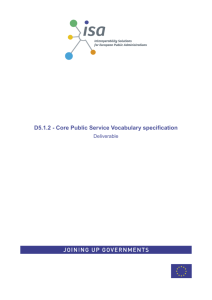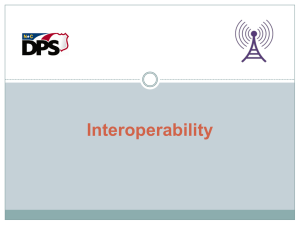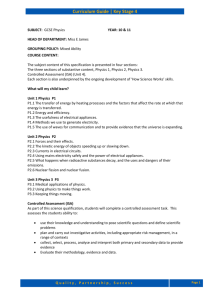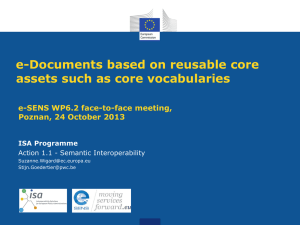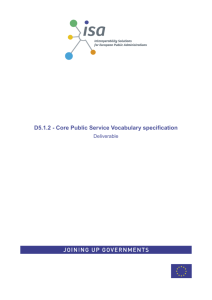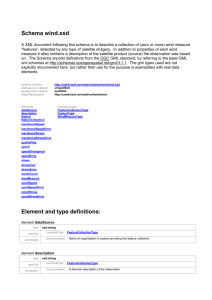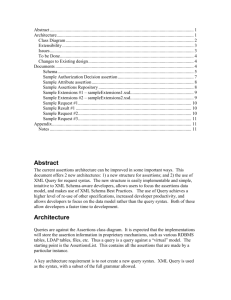D5.1.2 - Core Public Service Vocabulary specification
advertisement
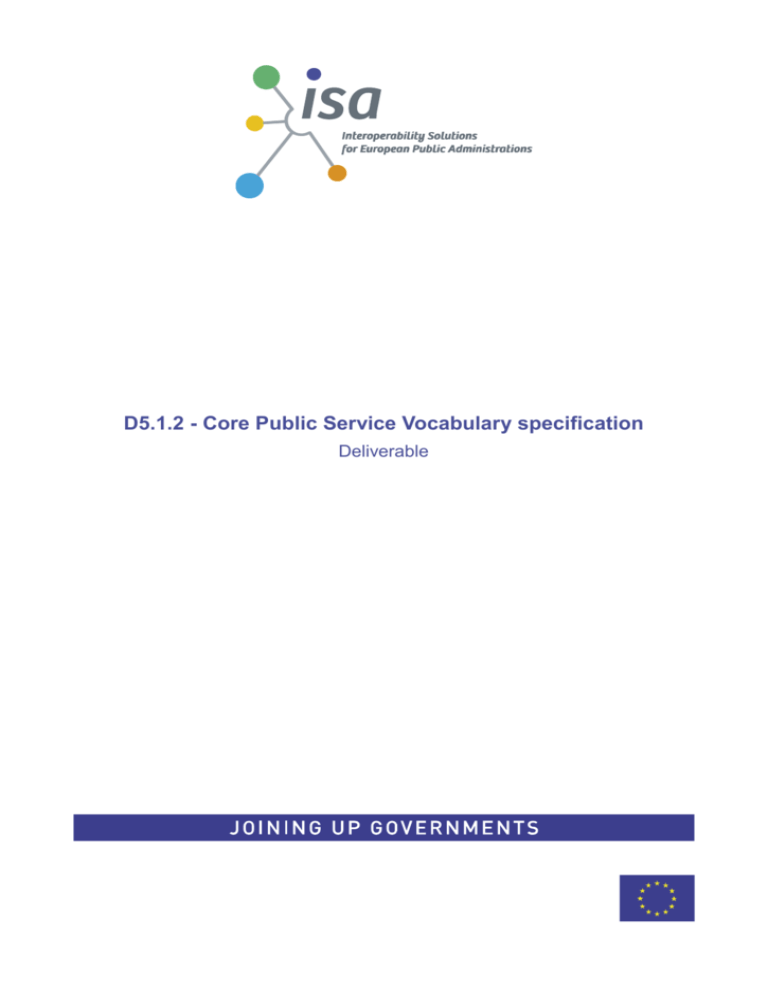
D5.1.2 - Core Public Service Vocabulary specification Deliverable i Document Metadata Property Value Release date 15/11/2012 Status Draft Version 0.02 Authors Phil Archer – W3C/ERCIM Stijn Goedertier – PwC EU Services Nikolaos Loutas – Pwc EU Services Reviewed by João Rodrigues Frade – PwC EU Services Approved by Document History Version Date Description Action 0.01 29/10/2012 Creation (ToC) Creation 0.02 15/11/2012 Initial thoughts, concepts scheme etc. Update ii Table of Contents 1. Title level 1 .................................................................... Error! Bookmark not defined. 1.1 Title level 2 .................................................................... Error! Bookmark not defined. 1.1.1 Title level 3 .................................................................... Error! Bookmark not defined. 1.1.1.1 Title level 4 ........................................................ Error! Bookmark not defined. iii List of Tables Table 1 – ISA Table 1 Style ........................................................................................................... 2 iv List of Figures Figure 1 – Figure 1 ........................................................................ Error! Bookmark not defined. 1 This is just a skeleton document. NONE of the content has been discussed or seen by the WG which is in the process of formation at the time of writing. 1. Introduction 1.1 About the ISA Programme This specification has been created as part of Action 1.1 [A1.1] of the Interoperability solutions for European public administrations (ISA) programme of the European Commission (EC). This programme funds initiatives to foster the efficient and effective cross-border electronic interactions between European public administrations. Action 1.1 of this programme is targeted towards improving the semantic interoperability of European e-Government systems. It addresses these by encouraging the sharing and reuse of semantic assets. As part of Action 1.1, the ISA Programme intends to build consensus on a number of e-Government Core Vocabularies for public sector information exchange. 1.2 Terminology This document uses the following terminology: Semantic interoperability is defined as the ability of information and communication technology (ICT) systems and the business processes they support to exchange data and to enable the sharing of information and knowledge: Semantic Interoperability enables systems to combine received information with other information resources and to process it in a meaningful manner (European Interoperability Framework 2.01). It aims at the mental representations that human beings have of the meaning of any given data. A Core Vocabulary is a simplified, reusable, and extensible data model that captures the fundamental characteristics of an entity in a context-neutral fashion [EGOV-CV]. Well known examples of existing Core Vocabularies include the Dublin Core Metadata Set [DC]. Such Core Vocabularies are the starting point for agreeing on new semantic interoperability assets and defining mappings between existing assets. Semantic interoperability assets that map to or extend such Core Vocabularies are the minimum required to guarantee a level of cross-domain and cross-border interoperability that can be attained by public administrations. 1.3 Objectives The Core Public Service Vocabulary (CPSV) is designed to make it easy to exchange basic information about the functions carried out by the public sector and the services in which those functions are carried out. By using the vocabulary, almost certainly augmented with sectorspecific information, organisations publishing data about their services will enable: 1 easier discovery of those services http://ec.europa.eu/isa/documents/isa_annex_ii_eif_en.pdf 2 easier discovery of the legislation and policies that underpin service provision; easier recognition of how services provided by a single organisation interrelate and are used either by other services or external users; easier comparison of service provision across different organisations. 1.4 Scope Any description of a public service will fit into a broader data set; for example: service users, metrics, outcomes, incidents and reports are all concepts likely to impinge on a service. In order to complete the current work in timely fashion, it is necessary to limit the scope and focus specifically on the core aspects of a service, recognising that it must fit in with existing and future vocabularies. That said, the CPSV must be broad enough so that it provides a framework for publishing data that is immediately useful and does not require the addition of terms that would need to be defined in future work. [The WG is likely to have a view on the scope of the work.] 1.5 Structure 3 2. Motivation The metadata and reference data used in electronic public services across Europe most often has a very specific context. Attaining consensus on common metadata and reference data for these electronic services is a critical step towards semantic interoperability. Unfortunately, consensus building is hindered by the diverse cultural, multi-lingual, legal, and organisational contexts of these e-Government services. To alleviate this problem, consensus building should start at a higher level of abstraction that surpasses the contexts of individual electronic public services, and thus the cultural, lingual, legal, and organisational differences of individual countries. In particular, consensus can be more easily attained on the semantics of a small set of fundamental concepts, for which less divergent opinions exist [EGOV-CV]. These concepts are what we describe as Core Vocabularies. 2.1 Use cases [See WG page on Joinup] 2.2 Related work Before embarking on the development of the CPSV, the working group notes and in many cases draws directly upon the following existing initiatives: The UK Public Sector Concept Model [PSCM] DG DIGIT's Catalogue of Services [ISA13] Vocabulario de trámites y servicios públicos [VTSP] ESD Toolkit Service List [SL4] KL Emnesystematik [KLE] Fælles Offentlig Referance Model [FORM] OASIS Transformational Government Framework [TGF] Greek Interoperability Centre Service Registry [ELSR] [To Do - summarise similarities - will come out of WG discussion] 4 3. Conformance Statement [This is taken from the conformance statement used by the GLD for its vocabularies] A data interchange, however that interchange occurs, is conformant with the Core Public Service Vocabulary if: it uses the terms (classes and properties) in a way consistent with their semantics as declared in this specification; it does not use terms from other vocabularies instead of ones defined in this vocabulary that could reasonably be used. A conforming data interchange: may include terms from other vocabularies; may use only a subset of Registered Organization vocabulary terms. A CPSV application profile is a specification for data interchange that adds additional constraints. Such additional constraints in a profile may include: a minimum set of required terms; classes and properties for additional terms not covered in the Core Public Service Vocabulary; controlled vocabularies or URI sets as acceptable values for properties; The Core Public Service Vocabulary is technology-neutral and a publisher may use any of the terms defined in this document encoded in any technology although RDF and XML are preferred. 5 4. Core Public Service Conceptual Model 4.1 Domain model Figure 1 UML diagram for the Core Public Service Vocabulary The conceptual model presented in Figure 1 is independent of any technology that may be used to represent it. It describes the minimal set of classes, relationships and properties necessary to describe a public service. Any description of a public service will fit into a broader data set; for example: users, metrics, outcomes, incidents and reports are all concepts likely to impinge on a service. TBD: The WG is likely to have a view on the scope of the work. The amount of work needs to 6 be manageable and therefore the scope should be limited in line with the concept of a Core Vocabulary. However, if the scope is too narrow it may be seen as insufficient to be useful. Services are typically established within a public administration to carry out a number of processes. For example, the Anywhere Regional Authority might establish a Fostering and Adoption Service that carries out processes including the maintenance of an At Risk Register. This hierarchy is reflected in the model so that in this example we would have: Conceptual Class Example Agent Anywhere Regional Authority Public Service Fostering & Adoption Process Maintain the At Risk Register Legislation and policies typically apply at the level of a process but may directly require the establishment of the service itself. There is almost always a planning stage between the establishment of a policy and the means to execute that policy. A plan will define one or more processes that are then performed by the service. The service may be provided by an independent organisation (a contractor, voluntary organisation etc.) in which case there will be some form of agreement between the authority that is responsible for ensuring that the service is available and the actual delivery organisation. In the following sections, each class is defined, followed by definitions of its properties (data type properties) and relationships (object properties). The Core Public Service Vocabulary is designed to work easily with the Organization Ontology [ORG] and re-uses some of its concepts. 4.2 The Public Service Class This class represents the service itself. Examples include a Debt Recovery Service, Family Court Service, Publications Service etc. 4.2.1 name Property name Data Type Text The name of the service. Language identifiers are particularly important in multilingual contexts 7 where a Service may have more than one name. 4.2.2 description Property description Data Type Text A free text description of the service. Language identifiers are particularly important in multilingual contexts where a Service may be described in multiple languages. 4.2.3 service type Property Object Type serviceType Code The type of service as described in a controlled vocabulary such as ESD Toolkit's Service List [SL4] 4.2.4 homepage Property Object Type homepage URL The Web homepage of the service. 4.2.5 has site Property Object Type hasSite Site A service will be carried out at, or organised from, one or more sites. The hasSite property and Site class are defined in the Organization Ontology [ORG] that provides methods for recording address and contact information. 8 4.3 The Process Class A process is a specific action that the service performs. 4.3.1 Possible properties name person/org responsible? site? Is Process simply a sub class of Service? 4.4 The Policy and Legislation Classes How much detail do we need to give for these? legislation.gov.uk uses FRBR and Metalex alongside DCT and FOAF to describe legislation, e.g. http://www.legislation.gov.uk/ukpga/1981/69/data.rdf So for here can we say "use those" and leave it at that?? It's a bit beyond the scope of the current work I'd say. 4.5 The Plan Class We could be equally non-committal about the Plan class - it will have the usual DCT properties how much do we need to spell out? Minded to leave it at "use DCT". 4.6 The Agreement Class If the WG decides that this is in scope then it will need a little thought. We're in danger of defining a vocabulary for describing a contract which is a whole different ball game. See also http://opendata.cz/public-contracts-ontology - that may be exactly what we need! 4.7 The DateTime Data Type Dates recorded within public sector data sets exist in many different formats. In order to make those dates interoperable, it is important that they should be represented in a regular manner wherever possible. The most widely used date formats are those that conform to ISO 8601:2004 [ISO 8601] of which the relevant XML Datatypes [XSD] are a subset. Dates should be recorded as formatted strings that are conformant with that standard with the relevant data type declaration. Known dates are recorded as literals in the form yyyy-mm-dd and then typed as xsd:date. 9 Where the full date and time are both known, and this can be important in records of death for example, use the xsd:dateTime format of yyyy-mm-ddThh:mm:ss with or without timezone information. Where just a year is known use xsd:gYear (yyyy) and where just the month is known use xsd:gYearMonth (yyyy-mm). The 'g' is for Gregorian. Non-Gregorian dates are not covered by XSD. For emphasis, the datatype should be explicitly stated so that software can correctly interpret the data. If a date is provided in a string that is conformant with a standard other than XSD, and that is not covered by XSD, then it should be typed accordingly. It should also be noted that the UK Government provides a URI scheme for time intervals that may be useful [DGUT] and that 8601:2004 itself allows intervals to be defined. In some public sector data sets, full dates are not always known. For example, dates such as "some time in the 1920s" or "between 1925 and 1932" are not uncommon. There is no agreed formal way to record such uncertainty dates and therefore an un-typed plain string should be used. In other words, a string like "between 1925 and 1932" cannot be improved upon. To use an interval as the value for, say, a date of birth, is incorrect, The date of birth is not the time interval that began in 1925 and ended in 1932, rather, it was an instant some time during that period. There is an important difference between declaring that an event occurred throughout a time interval and that it occurred at an unknown instant within a time interval. Some data sets use other methods to express uncertainty such as using false dates. Sometimes '00' or '??' is used to indicate uncertainty so that "August 1986" might be recorded as either 1986-00-00 or 1986-00-??. This practice is unnecessary and strongly discouraged, particularly if such dates are typed as XSD dates. If a string such as 1986-08-00 is fed to software expecting an xsd:date then it will either reject the data, in which case data is lost, or it might convert it to the nearest actual date 1986-08-01. In the latter case, the accurate yet imprecise date of "August 1986" has now been converted to a more precise date of 1 st August 1986 that may be anything up to 30 days wide of the truth. 4.7.1.1 In summary: use the appropriate XSD data type wherever possible (dateTime, date, gYearMonth, gYear); where data is missing, don't invent it or try to fool the system - just give the date as an un-typed string. 4.8 The Text data Type The text data type is a combination of a string and a language identifier. It is useful for names and descriptions that are available in multiple languages. Where this is so, each version of the data should be included and each one associated with the relevant language identifier. RFC 3066 [RFC 3066] provides a commonly used set of identifiers for natural languages. This is the 10 set recognised by UN/CEFACT and XML Schema. Languages are represented by two character codes, optionally followed by a locale definition such as "de" meaning German and "de-at" meaning "German as spoken in Austria." XML Example: <Location> <geographicName xml:lang="en">London</geoGraphicName> <geographicName xml:lang="fr">Londres</geoGraphicName> </Location> RDF Example: [] a locn:Location ; locn:geographicName "London"@en ; locn:geographicName "Londres"@fr . 11 5. Core Public Service Vocabulary in RDF 5.1 Namespace 5.2 RDF Schema 6. Approach & Community The process and methodology followed in the development is set out in detail in the Process and Methodology for Developing Core Vocabularies [PMDCV]. Specific acknowledgement is due to: 12 7. Change Control The Core Public Sector Vocabulary is published by the ISA Programme. Review comments and requests for changes can be made via the mailing list which is archived at @@@ Mailing list @@@. 8. Future work 8.1 Evolution of the model 8.2 Planned implementations 13 9. References [A1.1] Action 1.1 Improving semantic interoperability in European eGovernment systems http://ec.europa.eu/isa/actions/01-trusted-information-exchange/1-1action_en.htm [ADMS] The Asset Description Metadata Standard, http://joinup.ec.europa.eu/asset/adms/description [DBpedia] DBpedia is a community effort to extract structured information from Wikipedia and to make this information available on the Web. http://dbpedia.org/ [DC] DCMI Metadata Terms, Dublin Core Metadata Initiative. http://dublincore.org/documents/dcmi-terms/ [DGUT] data.gov.uk Time Intervals. Linked data for every time interval and instant into the past and future, from years down to seconds. This is an infinite set of linked data. It includes government years and properly handles the transition to the Gregorian calendar within the UK. http://thedatahub.org/dataset/data-gov-uktime-intervals [EGOV-CV] e-Government Core Vocabularies: The SEMIC.EU approach. Retrieved from European Commission - Directorate-General Informatics: http://www.semic.eu/semic/view/documents/egov-core-vocabularies.pdf [ELSR] Greek Interoperability Service Register, EPU-NTUA http://www.iocenter.eu/demos/service-registry-(greek--english).aspx [FOAF] Friend of a Friend http://xmlns.com/foaf/spec/ [FORM] Fælles Offentlig Referance Model (FORM) http://blog.modernisering.dk/ [ISA] Interoperability Solutions for European Public Administrations, http://ec.europa.eu/isa/ [ISA13] Accessing Member State information resources at European level http://ec.europa.eu/isa/actions/01-trusted-information-exchange/13action_en.htm [ISO 8601] Data elements and interchange formats -- Information interchange -Representation of dates and times, ISO 8601:2004. http://www.iso.org/iso/catalogue_detail?csnumber=40874 14 [ISO 19125] ISO 19125-1:2004 Geographic information -- Simple feature access -- Part 1: Common architecture See http://www.iso.org/iso/iso_catalogue/catalogue_tc/catalogue_detail.htm?csnumb er=40114) [JOINUP] The Joinup Platform is operated by the European Commission designed to enable the sharing and reuse open-source software, semantic assets and other interoperability solutions for public administrations. See http://joinup.ec.europa.eu/ [KLE] KL Emnesystematik, Local Governments Denmark http://www.kle-online.dk/ [ORG] An organization ontology, Dave Reynolds/W3C http://www.w3.org/TR/vocab-org/ [PMDCV] Process and Methodology for Developing Core Vocabularies, 22 November 2011. https://joinup.ec.europa.eu/elibrary/document/isa-deliverable-processand-methodology-developing-core-vocabularies [PSCM] Public Sector Concept Model, Under development by a consortium of UK government bodies lead by LeGSB. http://www.pauldcdavidson.com/pscm/index.php?Action=ShowModel&Id=3 [SCLS] Eurostat Standard Code Lists are available through the RAMON portal (http://ec.europa.eu/eurostat/ramon/). [SKOS] SKOS Simple Knowledge Organization System, Reference. Miles, A, Bechhofer, S, W3C Recommendation 18 August 2009. http://www.w3.org/TR/skos-reference/ [SL4] ESD Toolkit Service List 4 http://doc.esd.org.uk/ServiceList/4.00.html [TGF] OASIS Transformational Government Framework https://www.oasis-open.org/committees/tc_home.php?wg_abbrev=tgf [TOGM] Towards Open Government Metadata, Vassilios Peristeras, DG DIGIT, ISA Unit, September 2011 https://joinup.ec.europa.eu/sites/default/files/towards_open_government_metad ata_0.pdf [TURTLE] Terse RDF Triple Language, W3C http://www.w3.org/TR/turtle/ [UKCODE] Observation Status concept scheme. http://www.jenitennison.com/blog/files/codelists.ttl 15 [VTSP] Vocabulario de trámites y servicios públicos, CTIC, http://data.fundacionctic.org/vocab/infraestructuras/servicios.html [XSD] XML Schema Part 2: Datatypes Second Edition. W3C Recommendation 28 October 2004. http://www.w3.org/TR/xmlschema-2/#date 16 Annex I. The Core Public Service Working Group 17 Annex II. Core Public Service Vocabulary – Example in RDF
